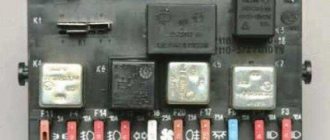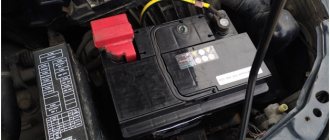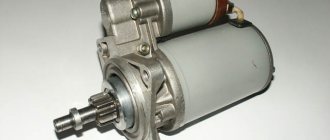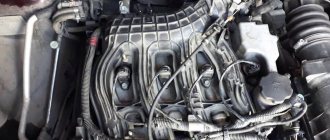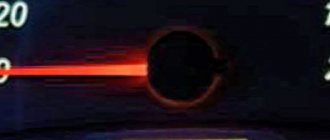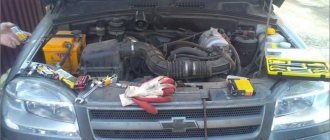Why do you need a car? If you don’t go into lyrical answers like “for the soul”, “for the sake of status” and other things - in order to ride it. And to do this, at a minimum, you need to start the car.
Every car owner sometimes has problems starting the engine. Most often the problem is a faulty starter. But what if the starter turns, but does not engage, the car does not start? In this article we will look at the main causes of such malfunctions, and also give some tips on how to eliminate them and avoid them in the future.
First, you need to make sure that the starter is really working. To do this, listen to the sound of its operation. If there are interruptions in the sound, it means that the starter contacts are not making good enough contact. The brushes may have worn out or the contacts of the electric drive have oxidized. If you recently replaced the starter and problems started, it is likely that poor-quality wiring was installed on the starter during assembly. Most often this happens when purchasing non-original spare parts.
By the way, if your solenoid relay clicks, but the starter does not turn, we advise you to read the article by following this link. We also hope that you find this material useful.
If the starter is in order, but the car still does not start, try checking your car in accordance with the algorithm presented below. It is likely that you will find the cause of the problem.
Reason #1: fuel system
The fuel supply may be interrupted. Try checking the fuel system for problems, ranging from the fuel pump to the carburetor or injector, depending on what is installed in your car.
Most often, problems arise in the fuel pump: try turning on the ignition and listen to whether the electric motor of the fuel pump is working. If you do not hear the noise of its operation, then that is the problem. The motor may be burnt out or there is no voltage on it. Then it is necessary to replace the fuse or, in particularly difficult cases, replace the entire fuel pump.
In carburetor cars, the situation with checking the gasoline pump is a little more complicated, since it is driven by the camshaft. To check it, remove the end of the hose from the carburetor inlet and pump the manual fuel lever several times. If no fuel comes out of the hose, the problem is in the fuel pump.
The car does not start when the starter is working normally: possible reasons
Let's start with the fact that at the beginning of the test you should once again make sure that the starter is working. During its operation, when trying to start the engine, there should be no clicks, hums or other extraneous sounds. A working starter should turn the engine with the characteristic buzz of the starter electric motor, and do it smoothly, without skipping or malfunctioning. If during attempts to start the internal combustion engine the indicated signs are noticed, then the fault should be looked for in the starter.
We also recommend reading the article about why the starter clicks/buzzes but does not turn the engine. From this article you will learn about the possible causes of the breakdown, as well as how to check the car starter yourself.
After making sure that the starter turns, but the engine does not start, you need to move on to a detailed check of certain vehicle systems. You should start by diagnosing the engine power system, as well as checking the ignition system and some sensors in the electronic control system of the internal combustion engine. In other words, an engine with a working starter most often does not start as a result of the fact that fuel does not enter the cylinders or the fuel does not ignite for certain reasons.
Checking the fuel system
The fuel system must be checked step by step, thereby excluding malfunctions of the following elements:
- electric fuel pump;
- mechanical fuel pump;
- injector;
- carburetor;
- fuel filters;
- fuel lines;
One should also not exclude possible air leaks into the fuel supply system. In the case of a diesel engine in winter, there is a high probability of waxing (freezing of diesel fuel), which simply is not pumped through the system in this form.
On cars with an injector, after turning the ignition key, you can usually clearly hear the sound of the electric fuel pump operating for a couple of seconds, pumping gasoline into the power system. If the fuel pump does not hum, then the fuel pump motor is likely to fail or there is no electricity supply to the pump. In this case, it is necessary to check the fuel pump, fuse and fuel pump relay.
We also recommend reading the article about why the fuel pump does not pump fuel. From this article you will learn about the main reasons for fuel pump failure, as well as ways to independently diagnose the device.
On cars with a carburetor, it is also necessary to check the fuel pump, which is structurally driven by the camshaft. Checking is carried out by removing the hose from the carburetor inlet fitting. You can also remove the hose from the fuel pump outlet. Next, you need to pump up the fuel using the manual pumping lever, which is located on the fuel pump. If everything is normal, then gasoline should flow.
On injection cars, you should check the presence of gasoline in the fuel rail (rail). On the specified ramp there is a valve-regulator that needs to be pressed. The presence of gasoline will indicate that fuel is being supplied through the rail to the injectors. At the same time, it is worth making sure that the fuel filter is not clogged, that is, it allows fuel to be pumped normally through the system. You should also pay attention to the throttle valve and clean this unit.
Ignition system diagnostics
If the starter turns and gasoline is supplied to the engine, but the engine does not start, you should check the functionality of the ignition system. You can exclude spark plugs and high-voltage wires from the list, since all of these elements cannot fail at the same time.
For this reason, it will be enough to unscrew one spark plug from the engine and then check for the presence of a spark. This procedure involves removing the spark plug, after which the spark plug wire is put on it. Then the spark plug skirt is applied to the engine cylinder block, after which the engine turns over from the starter. The presence of a spark will indicate that the ignition system is working properly. The absence of a spark on the spark plug will indicate a malfunction in the ignition module of an injection engine or the ignition coil on an engine with a carburetor.
To check the ignition coil of a carburetor engine, you will need to remove the central wire and bring its end 5-7 mm. to metal. After this, the engine is cranked by the starter. The absence of a spark in this case will clearly indicate problems with the coil. If there is a spark, then the next step in the diagnostic process is to remove the distributor cover and assess the condition of the device.
Reason #2: fuel filters
In principle, this could be attributed to the previous point, if not for the frequency with which this malfunction occurs. The starter turns, but does not engage, the car does not start, perhaps the engine does not have enough fuel as a result of a clogged fuel filter. After all, there is no need to talk about the quality of modern gasoline and the impurities in it. Even newbie car enthusiasts have heard about this.
Reason #3: ignition system
First of all, check if the candles are flooded. Remove the spark plugs and check if they have spark. To do this, put a high-voltage wire on the unscrewed spark plug, lean the spark plug against the engine and try to start it. If there is no spark, you will need to replace either the ignition module on the injector or the ignition coil on the carburetor engine. Don't ignore the distributor, at least inspect it externally. The lid must be intact, without chips or cracks, and there must also be no carbon deposits.
Reason #4: Throttle
The situation is approximately the same as with the fuel filter. If the valve is clogged, there may not be enough fuel to operate the engine or it may not flow there at all. The throttle body can be cleaned using carburetor cleaner and a brush; after cleaning, it is necessary to blow out the throttle body with compressed air.
When cleaning the throttle valve, it is worth remembering that on cars equipped with an on-board computer, it is necessary to “accustom” the system to the fact that the throttle valve is clean again. Because due to contamination, the on-board computer independently sets the damper to a certain position.
Tips and tricks
Many experts recommend that you be sure to take into account and note what preceded the startup problems and what signs might have appeared before more serious failures began.
In other words, if the car was recently filled with gasoline of questionable quality, then there is a high probability of problems with the fuel system. If there was a recent wash under the hood or the engine stopped starting in wet weather, then maximum attention should be paid to electrical equipment and wiring.
It also happens that at first the car begins to consume more fuel, the engine smokes, the car jerks when accelerating, dips are noted when pressing the gas pedal, etc., and only then the unit does not start. In such a case, the filters and fuel pump may well be to blame. By the way, a heavily contaminated air filter can also lead to the internal combustion engine simply being left without air and not starting.
In any case, often before the engine completely refuses to start, certain signs first appear. These signs should be recorded so that in the future it will be easier to determine the nature of the breakdown and quickly localize the fault.
If the problem catches the driver on the road, then during the initial diagnosis you need to turn on the headlights and low/high beam headlights. In the case when weak light is noted, the headlights come on and go out when the starter is cranked, then problems with the electrical circuits or battery are obvious.
Reason #5: Battery, wiring, terminals
Actually, the serviceability of the starter itself does not mean that the rest of the vehicle’s electrical system is working. Check to see if the battery is dead or if the terminals are oxidized. Faults and breaks in the electrical wiring can also cause the engine to refuse to start. For example, the wire that goes to the generator or from the positive terminal of the battery to power the controller could come off.
Quite often such a test does not give a positive result. Therefore, below we provide a list of reasons why the engine may not start, although they occur much less frequently:
- The integrity of the fuses is broken. Not the most common breakdown, but sometimes the engine does not start for this reason.
- Corrosion of parts. Particular attention should be paid to devices related to the vehicle's electrical network, for example, the same starter. Also check for corrosion on the spark plugs.
- Pay attention to the color of the carbon deposits on the candles. During engine operation, its formation is inevitable, but carbon deposits should be light brown in color. If the carbon deposits are black, the spark plug must be replaced. It is also unacceptable to use spark plugs with damaged or oily contacts.
- There is no spark at the ignition coil. In this case, we check the high voltage wire; its integrity may be compromised. In this case, the wire must be replaced. If it is ok, the ignition coil itself is probably faulty.
- Condensation under the hood. Sometimes the presence of excess moisture prevents the engine from starting. Place the car in a dry place, open the hood and wait for the moisture to evaporate. After this, try to start the engine. If the attempt is successful, try to find out where the excess moisture under the hood came from.
- Perform diagnostics on the on-board computer. It is likely that the immobilizer is activated. In this case, starting the engine is simply prohibited.
- Check if the crankshaft sensor is working properly. It may provide incorrect information to the on-board computer about the position of the crankshaft. A flammable mixture of the wrong composition may form. As a result, the starter turns, but does not engage, and the car does not start.
For efficient operation of a car engine, careful and proper care is required. Carry out regular preventive inspections, change consumables, and monitor the condition of your car. Also, don’t put off visiting a service station if your car suddenly starts acting up. This will not only avoid more serious malfunctions, but also prevent them in the future.
We also watch a video that will be especially useful for beginners: what to do if the starter turns, but the car does not start.
Why does the starter turn normally, but the engine does not catch and does not start?
In half the cases when a car refuses to start, the starter is to blame. At the same time, the other half occurs in situations where the starter regularly rotates the crankshaft, but the engine starts only after repeated attempts or is completely silent. This could be due to a variety of reasons.
Driver inattention or negligence
The notorious human factor can manifest itself in the most unexpected ways. For example, a banal lack of fuel or an alarm that blocks the fuel pump. It also happens that some “well-wisher” clogged the exhaust pipe, or a careless driver, while backing up, got stuck in a pile of soil or a snowdrift. Such reasons do not fall into the category of technical malfunctions, but they can spoil a lot of nerves.
Technical problems - starter malfunctions
Every more or less experienced driver will distinguish the sound of a starter, which regularly rotates the engine, from the useless buzz of its electric motor when there is no engagement with the flywheel.
When starting to troubleshoot, you should definitely make sure that the starter is functioning normally, and that no extraneous knocks, clicks or malfunctions are observed during its operation. The starter is considered faulty in the following cases:
- The Bendix gear cannot engage with the flywheel ring gear. This manifests itself in a loud metallic grinding sound that appears when the starter is turned on. The reason for this phenomenon is wear of the mating surfaces, chipped teeth, etc. The solution to the problem is to install a new flywheel or ring. The latter can be rotated 180° and thus avoids the need to purchase a new part.
- The overrunning clutch or retractor relay mechanism is stuck. At the same time, the starter motor hums, but it makes no attempt to start the engine. In some cases, repeated attempts to turn on the starter help, but this only postpones the need for repair or replacement for some time.
- The crown is loose. A similar malfunction occurred on cars from the end of the last – beginning of this century, including the popular “nines”. In this case, the starter engages with the ring and begins to turn it, but it turns on the flywheel with a grinding noise. Only replacing the latter will help.

